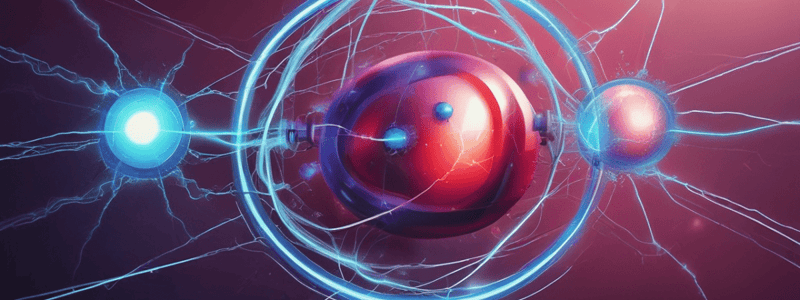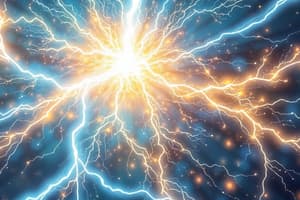Podcast
Questions and Answers
What is the formula for electrosatic force?
What is the formula for electrosatic force?
- F = ma
- F = mg
- F = Q1Q2/4πEd^2 (correct)
- F = Q
What happens when like charges interact with each other?
What happens when like charges interact with each other?
- They neutralize each other
- They move towards the nucleus
- They attract each other
- They repel each other (correct)
Which process causes polythene to become negatively charged?
Which process causes polythene to become negatively charged?
- Heating it in a furnace
- Dipping it in water
- Exposing it to light
- Rubbing it against cloth (correct)
What is a conductor?
What is a conductor?
What is point discharge primarily associated with?
What is point discharge primarily associated with?
What does the gold leaf electroscope help to identify?
What does the gold leaf electroscope help to identify?
How does the permittivity of the medium surrounding charges affect the electrostatic force?
How does the permittivity of the medium surrounding charges affect the electrostatic force?
In which scenario is the electric force the greatest?
In which scenario is the electric force the greatest?
What is an electric field line?
What is an electric field line?
What does electric field strength measure at a point in an electric field?
What does electric field strength measure at a point in an electric field?
What is the formula for electric filed strenght?
What is the formula for electric filed strenght?
Flashcards are hidden until you start studying
Study Notes
Electric Charge
- Electric charge (Q or q) determines if a body has more or less electrons than protons.
- The unit of charge is coulomb (C).
Atomic Structure
- An atom consists of three particles: protons, neutrons, and electrons.
- Protons and neutrons are located in the centre of the atom, while electrons orbit the nucleus.
Charge Interactions
- Like charges repel each other, while unlike charges attract each other.
- Rubbing cloth and polythene causes polythene to become negatively charged, while rubbing cloth against perplex causes perplex to become positively charged.
Conductors and Insulators
- A conductor is any substance that allows electric charge to flow through it.
- An insulator is any substance that prevents electric charge from flowing through it.
- All static charges reside on the outside of a conductor.
Static Charge on Conductors
- Static charge on a conductor tends to accumulate where the conductor is most pointed.
- Point discharge occurs at a very sharp point due to charge density, resulting in a strong electric field being created.
Ions and Charge Neutralization
- Ions are both attracted and repelled, neutralizing the object.
- This can be demonstrated by showing the effect of the 'electric wind' created on a naked flame.
Gold Leaf Electroscope
- The gold leaf electroscope is used to detect small charges, estimate the size of a charge, identify the sign of the charge, and distinguish between a conductor and insulator.
- It consists of multiple components, including a thin gold leaf placed close to a metal rod.
- If the gold leaf and metal rod are charged with the same sign, they repel each other.
Coulomb's Law
- The force between two point charges is proportional to the product of their charges and inversely proportional to the square of the distance between them.
- Unit = newton (N)
- The size of the force is the same on each body, and the force is along the line between them.
Factors Affecting Electrostatic Force
- One of the factors affecting the size of the electrostatic force is the permittivity () of the medium surrounding the charges.
- If the permittivity is low, the force is big; permittivity and force are inversely proportional.
- The force is greatest when the charges are in a vacuum.
Electric Field
- An electric field is any region of space where a static electric charge experiences a force other than the force of gravity.
- An electric field line is the line along which a positive charge would move if placed in the electric field.
- The electric field strength (E) at a point in an electric field is the force per unit positive charge at that point.
- S.I. Unit = newton per coulomb (N C-1) or volt per meter (V/m).
Studying That Suits You
Use AI to generate personalized quizzes and flashcards to suit your learning preferences.




